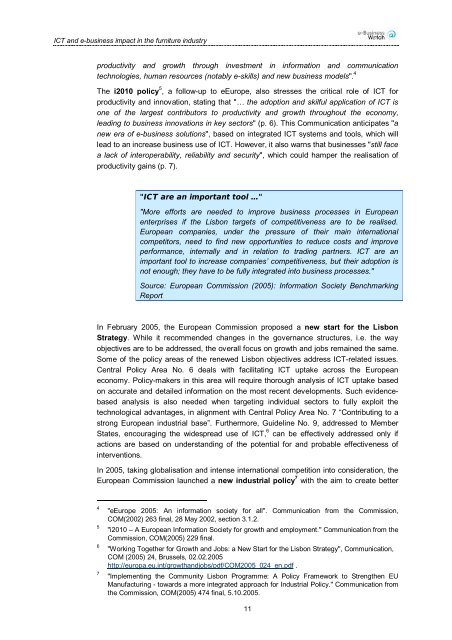<strong>ICT</strong> <strong>and</strong> e-bus<strong>in</strong>ess impact <strong>in</strong> <strong>the</strong> furniture <strong>in</strong>dustryproductivity <strong>and</strong> growth through <strong>in</strong>vestment <strong>in</strong> <strong>in</strong>formation <strong>and</strong> communicationtechnologies, human resources (notably e-skills) <strong>and</strong> new bus<strong>in</strong>ess models". 4The i2010 policy 5 , a follow-up to eEurope, also stresses <strong>the</strong> critical role of <strong>ICT</strong> forproductivity <strong>and</strong> <strong>in</strong>novation, stat<strong>in</strong>g that "… <strong>the</strong> adoption <strong>and</strong> skilful application of <strong>ICT</strong> isone of <strong>the</strong> largest contributors to productivity <strong>and</strong> growth throughout <strong>the</strong> economy,lead<strong>in</strong>g to bus<strong>in</strong>ess <strong>in</strong>novations <strong>in</strong> key sectors" (p. 6). This Communication anticipates "anew era of e-bus<strong>in</strong>ess solutions", based on <strong>in</strong>tegrated <strong>ICT</strong> systems <strong>and</strong> tools, which willlead to an <strong>in</strong>crease bus<strong>in</strong>ess use of <strong>ICT</strong>. However, it also warns that bus<strong>in</strong>esses "still facea lack of <strong>in</strong>teroperability, reliability <strong>and</strong> security", which could hamper <strong>the</strong> realisation ofproductivity ga<strong>in</strong>s (p. 7)."<strong>ICT</strong> are an important tool …""More efforts are needed to improve bus<strong>in</strong>ess processes <strong>in</strong> Europeanenterprises if <strong>the</strong> Lisbon targets of competitiveness are to be realised.European companies, under <strong>the</strong> pressure of <strong>the</strong>ir ma<strong>in</strong> <strong>in</strong>ternationalcompetitors, need to f<strong>in</strong>d new opportunities to reduce costs <strong>and</strong> improveperformance, <strong>in</strong>ternally <strong>and</strong> <strong>in</strong> relation to trad<strong>in</strong>g partners. <strong>ICT</strong> are animportant tool to <strong>in</strong>crease companies’ competitiveness, but <strong>the</strong>ir adoption isnot enough; <strong>the</strong>y have to be fully <strong>in</strong>tegrated <strong>in</strong>to bus<strong>in</strong>ess processes."Source: European Commission (2005): Information Society Benchmark<strong>in</strong>gReportIn February 2005, <strong>the</strong> European Commission proposed a new start for <strong>the</strong> LisbonStrategy. While it recommended changes <strong>in</strong> <strong>the</strong> governance structures, i.e. <strong>the</strong> wayobjectives are to be addressed, <strong>the</strong> overall focus on growth <strong>and</strong> jobs rema<strong>in</strong>ed <strong>the</strong> same.Some of <strong>the</strong> policy areas of <strong>the</strong> renewed Lisbon objectives address <strong>ICT</strong>-related issues.Central Policy Area No. 6 deals with facilitat<strong>in</strong>g <strong>ICT</strong> uptake across <strong>the</strong> Europeaneconomy. Policy-makers <strong>in</strong> this area will require thorough analysis of <strong>ICT</strong> uptake basedon accurate <strong>and</strong> detailed <strong>in</strong>formation on <strong>the</strong> most recent developments. Such evidencebasedanalysis is also needed when target<strong>in</strong>g <strong>in</strong>dividual sectors to fully exploit <strong>the</strong>technological advantages, <strong>in</strong> alignment with Central Policy Area No. 7 “Contribut<strong>in</strong>g to astrong European <strong>in</strong>dustrial base”. Fur<strong>the</strong>rmore, Guidel<strong>in</strong>e No. 9, addressed to MemberStates, encourag<strong>in</strong>g <strong>the</strong> widespread use of <strong>ICT</strong>, 6 can be effectively addressed only ifactions are based on underst<strong>and</strong><strong>in</strong>g of <strong>the</strong> potential for <strong>and</strong> probable effectiveness of<strong>in</strong>terventions.In 2005, tak<strong>in</strong>g globalisation <strong>and</strong> <strong>in</strong>tense <strong>in</strong>ternational competition <strong>in</strong>to consideration, <strong>the</strong>European Commission launched a new <strong>in</strong>dustrial policy 7 with <strong>the</strong> aim to create better4567"eEurope 2005: An <strong>in</strong>formation society for all". Communication from <strong>the</strong> Commission,COM(2002) 263 f<strong>in</strong>al, 28 May 2002, section 3.1.2."i2010 – A European Information Society for growth <strong>and</strong> employment." Communication from <strong>the</strong>Commission, COM(2005) 229 f<strong>in</strong>al."Work<strong>in</strong>g Toge<strong>the</strong>r for Growth <strong>and</strong> Jobs: a New Start for <strong>the</strong> Lisbon Strategy", Communication,COM (2005) 24, Brussels, 02.02.2005http://europa.eu.<strong>in</strong>t/growth<strong>and</strong>jobs/pdf/COM2005_024_en.pdf ."Implement<strong>in</strong>g <strong>the</strong> Community Lisbon Programme: A Policy Framework to Streng<strong>the</strong>n EUManufactur<strong>in</strong>g - towards a more <strong>in</strong>tegrated approach for Industrial Policy." Communication from<strong>the</strong> Commission, COM(2005) 474 f<strong>in</strong>al, 5.10.2005.11
<strong>ICT</strong> <strong>and</strong> e-bus<strong>in</strong>ess impact <strong>in</strong> <strong>the</strong> furniture <strong>in</strong>dustryframework conditions for manufactur<strong>in</strong>g <strong>in</strong>dustries <strong>in</strong> <strong>the</strong> com<strong>in</strong>g years. Some of <strong>the</strong>policy str<strong>and</strong>s described have direct l<strong>in</strong>ks to <strong>ICT</strong> usage, recognis<strong>in</strong>g <strong>the</strong> importance of<strong>ICT</strong> for <strong>in</strong>novation, competitiveness <strong>and</strong> growth.The new EU <strong>in</strong>dustrial policy aimed at complement<strong>in</strong>g work at Member State level tosupport a strong <strong>and</strong> dynamic <strong>in</strong>dustrial base. It <strong>in</strong>cluded seven new <strong>in</strong>itiatives - oncompetitiveness, energy <strong>and</strong> <strong>the</strong> environment, on <strong>in</strong>tellectual property rights, on betterregulation, on <strong>in</strong>dustrial research <strong>and</strong> <strong>in</strong>novation, on market access, on skills, <strong>and</strong> onmanag<strong>in</strong>g structural change – aimed at support<strong>in</strong>g a wide range of <strong>in</strong>dustry sectors. Theapproach underly<strong>in</strong>g <strong>the</strong> new <strong>in</strong>dustrial policy is based on <strong>the</strong> screen<strong>in</strong>g of 27 <strong>in</strong>dividualsectors of manufactur<strong>in</strong>g <strong>in</strong>dustry <strong>and</strong> construction, <strong>the</strong> furniture sector <strong>in</strong>cluded. This<strong>in</strong>dustrial policy is an important step <strong>in</strong> <strong>the</strong> delivery of <strong>the</strong> Commission’s Lisbon“Partnership for Growth <strong>and</strong> Jobs. In May 2007 <strong>the</strong> “Study on <strong>the</strong> competitiveness,economic situation <strong>and</strong> location of production <strong>in</strong> <strong>the</strong> textiles <strong>and</strong> cloth<strong>in</strong>g, footwear,lea<strong>the</strong>r <strong>and</strong> furniture <strong>in</strong>dustries” 8 has been issued by <strong>the</strong> European Commission. Thestudy provides a comprehensive overview of <strong>the</strong> competitive scenario of <strong>the</strong>se fashionrelated<strong>in</strong>dustries; it also provides <strong>in</strong>dications <strong>and</strong> recommendations on how to enhance<strong>the</strong> competitive position of <strong>the</strong> enlarged European <strong>in</strong>dustry. The study team hasthoroughly analysed this document <strong>and</strong> has built upon its relevant f<strong>in</strong>d<strong>in</strong>gs <strong>and</strong>conclusions <strong>in</strong> particular for develop<strong>in</strong>g <strong>the</strong> <strong>in</strong>dustry scenario <strong>and</strong> <strong>the</strong> recommendationsfor policy implications.The SeBW is one of <strong>the</strong> policy <strong>in</strong>struments used by DG Enterprise <strong>and</strong> <strong>Industry</strong> tosupport <strong>the</strong> implementation of <strong>the</strong> <strong>in</strong>dustrial policy <strong>and</strong> related programmes. Its activitiesare complementary to o<strong>the</strong>r related policy programmes <strong>in</strong> <strong>the</strong> field of <strong>ICT</strong>, such as:<strong>the</strong> e-<strong>Bus<strong>in</strong>ess</strong> Support Network (eBSN), a European network of e-bus<strong>in</strong>ess policymakers <strong>and</strong> bus<strong>in</strong>ess support organisations,<strong>the</strong> eSkills Forum, a task force established <strong>in</strong> 2003 to assess <strong>the</strong> dem<strong>and</strong> <strong>and</strong>supply of <strong>ICT</strong> <strong>and</strong> e-bus<strong>in</strong>ess skills <strong>and</strong> to develop policy recommendations,<strong>the</strong> <strong>ICT</strong> Task Force, a group whose work is to draw toge<strong>the</strong>r <strong>and</strong> <strong>in</strong>tegrate variousactivities aim<strong>in</strong>g to streng<strong>the</strong>n Europe's <strong>ICT</strong> sector, <strong>and</strong>activities <strong>in</strong> <strong>the</strong> areas of <strong>ICT</strong> st<strong>and</strong>ardisation, as part of <strong>the</strong> general st<strong>and</strong>ardisationactivities of <strong>the</strong> Commission.9In parallel to <strong>the</strong> work of <strong>the</strong> SeBW, <strong>the</strong> "Sectoral Innovation Watch" (see www.europe<strong>in</strong>nova.org)analyses <strong>in</strong>novation performance <strong>and</strong> challenges across different EU sectorsfrom an economic perspective. Studies cover, <strong>in</strong>ter alia, <strong>the</strong> follow<strong>in</strong>g sectors: chemical,automotive, aerospace, food, <strong>ICT</strong>, textiles, mach<strong>in</strong>ery <strong>and</strong> equipment.Scope of <strong>the</strong> programmeS<strong>in</strong>ce 2001, <strong>the</strong> SeBW <strong>and</strong> its predecessor "e-<strong>Bus<strong>in</strong>ess</strong> W@tch" have published e-bus<strong>in</strong>ess studies on about 25 sectors 10 of <strong>the</strong> European economy, annualcomprehensive syn<strong>the</strong>sis reports about <strong>the</strong> state-of-play <strong>in</strong> e-bus<strong>in</strong>ess <strong>in</strong> <strong>the</strong> EuropeanUnion, statistical pocketbooks <strong>and</strong> studies on specific <strong>ICT</strong> issues. All publications can be8910Available at http://ec.europa.eu/enterprise/furniture/<strong>in</strong>dex_en.htm.The 2006 <strong>ICT</strong> St<strong>and</strong>ardisation Work Programme complements <strong>the</strong> Commission's "Action Planfor European St<strong>and</strong>ardisation" of 2005 by deal<strong>in</strong>g more <strong>in</strong> detail with <strong>ICT</strong> matters.see overview at www.ebus<strong>in</strong>ess-watch.org/studies/on_sectors.htm.12
















